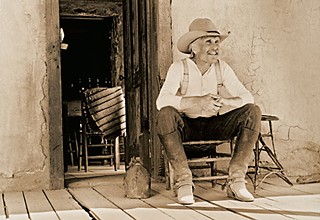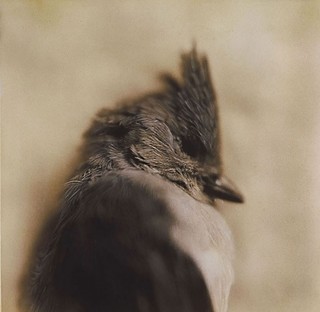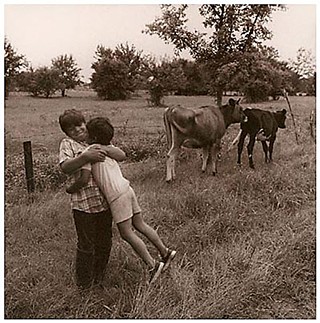A Sense of Place
For two decades, Stephen L. Clark's gallery has made a home for photographers of the region
By Robert Faires, Fri., Oct. 18, 2013
Pictures at an exhibition: the grizzled actor on the movie set, perched on the porch of some weathered stucco bunkhouse, butt sunk deep in a sagging wooden chair but trunk leaning forward, elbows on knees, and beneath the crisp cowboy hat and, farther down, the wire-brush mustache, a playful grin, gleaming teeth as white as the long-sleeved undershirt he wears and the tops of his dust-crusted boots.
The bird in profile, the edges of head and body blurred, its eye lost in shadow but the delicate feathering beneath it in crisp detail like the creases in the face of an ancient cleric, the tightly clamped beak and vertical crest suggesting a dour cardinal in slumber, dreaming of sinners enjoying themselves.
The two young brothers in a playful embrace, the elder hugging his little sibling so tight that his sneakers don't even touch the weeds in the pasture where two cows who couldn't be less interested amble away along the line of the barbed wire fence.
The back of the university football stadium, the monumental concrete upper deck curving downward into the center of the frame, its edges seared by the blazing light directed at the playing field, its reflected light caught in the overcast sky, illuminating it like some eerie aurora.
Picture not at an exhibition: bespectacled man in a roomful of art, framed prints of silverpoint images hanging behind and above his head like lustrous angels hovering over him, the desk where he sits piled high with books full of more pictures, his illuminated manuscripts, his Bibles whose Word is the image captured in light on film. Behind the round lenses, his eyes dance with passion and history, a rich appreciation for the photographic work surrounding him and for its makers, with whom he shares connections longstanding. Indeed, he is the binding force for those photographs described above, the glue that has held them and their creators together. He is Steve Clark, a gallerist who more or less fell into the trade after walking away from a successful turn as a restaurateur. But his passion for the work – that is, the work produced by great photographers and the work of promoting and selling their images – combined with the exceptional quality of the artists he represents, has made his accidental profession not just a commercial success for two decades but also a major proponent of regional photography. This week, Clark marks the milestone of 20 years showing photographs with an exhibition the likes of which he thinks haven't been seen before. Whether or not all the photographs hung together in this story's opening paragraphs actually will be hanging on the walls of the Stephen L. Clark Gallery this weekend, you can bank on there being images of some kind by the artists who made them – Bill Wittliff, Kate Breakey, Keith Carter, and Sean Perry, respectively – because they are all part of the history of this gallery, deeply threaded into its development, evolution, and success.
Indeed, to hear Clark tell it – or, in this case, see Clark tell it, as his account of the gallery's origins to me arrived in glorious cursive longhand, spread across a half-dozen full-sized pages of stationery – the early history of the Stephen L. Clark Gallery is a daisy chain of photographers, each connecting to another in a way that moves the gallery another step along the way. When Clark sold his interest in Waterloo Ice House and was seeking the next path in life, it was his college roommate, photographer Rick Williams, who suggested that Clark sell his work and the work of photographer Ave Bonar. Then they made a list of names of other photographers he might approach, but first Clark made a point of mentioning his plan to screenwriter and photographer Bill Wittliff, who not only allowed Clark to sell the images he made during the filming of Lonesome Dove, but also suggested that Clark take on "this guy from Beaumont" who was making such a splash in the business. That guy, Keith Carter, provided the material for Clark's second exhibition – James Evans was first, showing his images of the Big Bend and its legendary grande dame, Hallie Stillwell, in a Tarrytown gallery then run by Bill Davis – and at the opening of the Carter show appeared a young woman who introduced herself to Clark as a photographer. Her name was Kate Breakey, and when Clark delivered a print of Carter's she had bought to her Hyde Park home, he saw her photographic work for the first time and was "stunned." He then invited Wittliff to see her work, and after he did, he left with 22 of her hand-painted, large gelatin silver prints. And so it went with these and other prodigiously gifted photographers – Jack Spencer, Rocky Schenck, Robb Kendrick, Sean Perry, to name but a few – linking to Clark and sometimes to one another in ways that built their own reputations and the gallery's.
But the linkage of these artists wasn't simply about the quality of their work or its commercial appeal. Keith Carter has often told of attending a talk by Horton Foote in which the Texas playwright and screenwriter said, "An artist needs a sense of place." It led him to look anew at the world he lived in, Southeast Texas, and provided a vision for his photography. If the artists shown at Stephen L. Clark Gallery share any quality, it's that "sense of place" that Foote described. Whether it's Wittliff's portraits of Robert Duvall as Gus or Breakey's portraits of deceased birds, a cow pasture by Carter or a stadium by Perry, the images are rooted in Texas and its adjoining territories. There were certainly photographers whose work radiated Austin and Texas and the Southwest before Clark opened the gallery, but they were dispersed across the city and state. Clark created a home for them that hadn't existed before, and in bringing them together and maintaining this place, he gave this particular form of regional art – pardon the pun – focus.
Clark acknowledges the connection with place when he writes, "I've said many times that I could have opened with the most famous photographers in the world and would not have made it a year. There are many closed galleries in Austin that prove that. I had Keith, Bill, Jack, James, Rocky, and others that meant something to the region but were nationally or internationally recognized. To have many of the best photographers working in my part of the world is lucky indeed."
But beyond that coincidence of location, luck has little to do with the endurance and significance of the Stephen L. Clark Gallery. That comes down more to one man's eye for extraordinary images, his unswerving belief in the power of art, his desire to help people learn about the work he shows, and his drive to help artists make a living from the work they make. In a Chronicle feature in 2004, Clark told writer Sam Martin, "I preach art because I think it's important to live with a constant influx of it. Every day I wake up at 6am, and the first thing I do is listen to music. What I do here is help people surround themselves with things that are meaningful."
"So, 20 years later, we come to this show," his letter concludes – a show that brings together Carter and Cartier-Bresson, Breakey and Mariana Yampolsky, Wittliff and Graciela Iturbide, plus Peter Brown and Elliott Erwitt – in short, a collection of premier regional talents and some of the greats of the world and a culmination of Clark's two decades as a gallerist. "We have talked to whomever would listen, young and old, buyer and looker, for 5,000 days. We've left them alone to bask or consider, if that was their preference. We've done near 100 shows. We've been involved with the publication of many books. Photography, literature, music, and film has mingled within our walls. As John Graves said when his cluster fly outfished the guide's recommendation, 'It's a triumph, that's what it is, a triumph!'"
Stephen L. Clark Gallery's 20th Anniversary Show will be on view Oct. 19-Dec. 7, at the gallery, 1101 W. Sixth. Opening reception is Saturday, Oct. 19, 6–9pm. For more information, call 512/477-0828, or visit www.cowboyfineartphotographs.com.
















